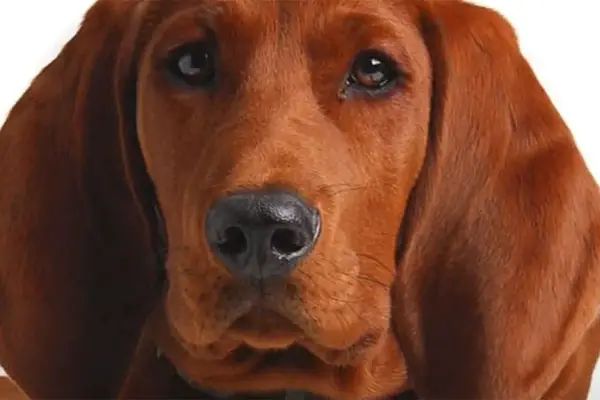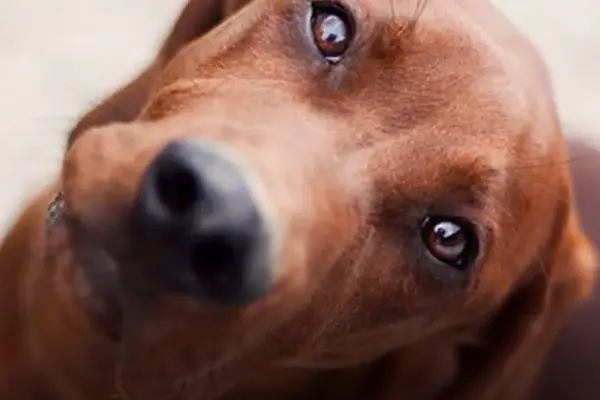Redbone Coonhounds are medium to large-sized hounds with muscular bodies covered with beautiful red coats. The Redbone Coonhound features a typical, classic hound head and ears that are long enough to reach their noses. They also have brown eyes that are full of emotion that you would just adore.
Redbone Coonhounds make excellent companion dogs, and they can adapt to any type of living. However, they do sing a lot, which can cause inconvenience to neighbors. So, if you’re living in an apartment, these dogs may not be for you.
They are the best fit for those who love the outdoors as they can manage to work on all kinds of terrain. They also move with confidence and certainty, perfect fit for hikers and hunters alike. However, these dogs are independent thinkers, so unless you can provide consistent and firm leadership, Redbone Coonhounds may not be for you.

Redbone Coonhound Breed Statistics
| Dog Breed Group | Hound Group |
| Breed Size | Medium |
| Height | 22-27 inches (male); 21-26 inches (female) |
| Weight | 45-70 pounds |
| Lifespan | 12-15 years |
Redbone Coonhound Breed Ratings
| Energy level | |
| Exercise needs | |
| Requires attention | |
| Playfulness | |
| Trainability | |
| Shedding | |
| Grooming | |
| Friendly with family | |
| Friendly with kids | |
| Friendly with strangers | |
| Friendly with other dogs | |
| Prey Drive |
Redbone Coonhound History
Redbone Coonhounds or Redbones, in short, are one of the few breeds developed in America. It is believed that they descended from red foxhounds brought by Scottish immigrants to the US in the late 18th century.
The name Redbone came from a breeder named Peter Redbone. But the one who did the most to develop the breed was George E. Birdsong from Georgia.
The foxhounds brought by Scottish immigrants were crossbred with Irish hounds and other bloodhounds. This resulted in the Redbone Coonhound, a dog with a red coat and impressive raccoon-hunting traits.
By the end of the 19th century, the Redbone Coonhound is already a well-established breed, and Redbones continued to become excellent hunting companions. By the year 1902, the United Kennel Club registered the Redbone Coonhound.
However, it wasn’t until 2009 that the American Kennel Club recognized the dog breed. Now, the dogs rank 142nd as the most popular dog breed in the US today.
Redbone Coonhound Temperament
Redbone Coonhounds are even-tempered, amiable, and eager to please dogs. They are developed to be working dogs to hunt large and small game, so it’s only natural that they be given hard physical exercise to remain happy.
The Redbones are believed to be the most laid back out of all the Coonhound dog breeds. They adapt well to indoor living, and they are effortless to housetrain. They are also attention-seekers, so be sure to spend a lot of time with him so he won’t be a big problem.
These dogs are known to be good and gentle with children, and they can get along with other pets as well. But staying true to their hunter origin, they tend to chase cats and other small animals.
They are reserved when it comes to strangers and will bark when someone suspicious comes to your home. However, they are not aggressive unless he sees any threat.
Early socialization is critical when it comes to raising a Redbone. This will help build up his confidence, so they become more well-rounded. And though they are easy to train, you should do it with consistency, and it needs to be clear to him that he should follow you.
Redbone Coonhounds are independent-thinkers and will try to do things his way. We recommend giving lots of positive reinforcements and never hit him.
Redbone Coonhound Care Requirements
- Nutrition: Redbone Coonhounds would only require a high-quality and well-balanced diet to remain healthy. It should consist of all the essential nutrients for their growth. This includes proteins, fats, and carbohydrates. If you’re going to feed your dog with home cooked meals, you should only buy high-quality ingredients. There are many great sources of proteins, fats, and carbohydrates that you can buy in the market, but you can also ask your vet for the right guide. Fruits and vegetables are great to add to your dog’s diet as these aid digestion. For dog food, choose only the premium quality ones. Always check the label and make sure that it doesn’t contain fillers, additives, and by-products that can harm your dog. If your dog is allergic to any food ingredient, stay away from those too. Be careful about the number of calories you’re feeding your dog. It’s best if you also ask your vet for advice as this can depend on your dog’s age, metabolism, and activity level.
- Grooming: Redbone Coonhounds have short, smooth coats that shed seasonally. It is highly recommended to brush them thoroughly at least once a week. This will help remove excess hair and dirt from your dog’s coat, keeping the shedding at a minimum. However, during the shedding season, you might need to do this daily. Baths should be given once a month or more frequently to keep his skin clean and healthy. These dogs may have that doggy odor, especially if they have done lots of physical activities. However, we recommend cleaning the ears once a week to prevent ear infection. Nails should be trimmed once every two weeks to prevent it from becoming too long.
- Exercise: Redbone Coonhounds are energetic dogs that need their regular but moderate exercise. Physical activities will help keep him happy and healthy. That’s why they make excellent companions for those who love the outdoors and do activities like running, biking, or hiking. Make sure to keep them on-leash when you’re outside fenced areas. They have a strong prey drive and will run off in the scent of prey.
- Health: Redbone Coonhounds are generally healthy dogs with a long lifespan. However, like any other dog breeds, they are prone to some health conditions. There are two health problems that you need to watch out for – hip dysplasia and ear infection. This can easily be prevented by giving him the right care, nutrition, and exercise. Just make sure to monitor their behaviors continuously, and if you happen to detect any changes, take him immediately for a check-up. These two are the most common, but there may also be other conditions that may come around. We recommend meeting at least one of your dog’s parents to be aware of any existing diseases that your dog might get from them.
- Lifespan: The life expectancy of Redbone Coonhounds is 12-15 years.

Famous Redbone Coonhounds
- Little Ann and Old Dan: Redbone Coonhounds from the book Where the Red Fern Grows
Fun Facts about Redbone Coonhounds
- Redbone Coonhounds first appeared in the United States around the 1700s.
- The name came from a breeder named “Peter Redbone” of Tennessee.
- They were developed by crossing Bloodhounds and English Foxhounds.
- They were originally bred to hunt bears, cougars, and raccoons.
- They have short, smooth coats that come in shades of red.
- They were recognized by the American Kennel Club in 2001.
Check Out Other Hound Dog Breeds:
Afghan Hound, American English Coonhounds, American Foxhound, Basenjis, Basset Hound, Beagle, Black and Tan Coonhound, Bloodhound, Bluetick Coonhound, Borzois, Cirnechi dell’Etna, Dachshund, English Foxhound, Grand Basset Griffon Vendeens, Greyhound, Harrier, Ibizan Hound, Icelandic Sheepdogs, Irish Wolfhound, Norwegian Elkhound, Otterhound, Petit Basset Griffon Vendéen, Pharaoh Hounds, Plotts, Portuguese Podengo, Rhodesian Ridgeback, Salukis, Scottish Deerhounds, Sloughis, Treeing Walker Coonhound, Whippet
